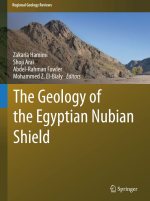Добрый день, Коллеги. Важное сообщение, просьба принять участие. Музей Ферсмана ищет помощь для реставрационных работ в помещении. Подробности по ссылке
The geology of the Egyptian Nubian shield / Геология Египетско-Нубийского щита
The history of recorded geological observations of the Egyptian Eastern Desert and Sinai is divided into five stages: Pharaonic, Roman to early Ottoman, nineteenth century, twentieth century to the 1950s and post-1950s. Pharaonic interests were mainly resource-focused (gold, gemstones, hard stone) and are exemplified by the Turin Papyrus geological map. Roman to early Ottoman activities followed similar motivations and transported huge quantities of Egyptian stone across the Mediterranean. The nineteenth century saw the first scientific observations, with the French Expedition, and later with the maps produced by intrepid German explorers, Rohlfs, Zittel and Schweinfurth. This stage concluded with the momentous founding of the Egyptian Geological Survey by Henry G. Lyons. In the first half of the twentieth century, William Fraser Hume and colleagues Ball, Barron and Beadnell conducted fundamental mapping programs that formed the basis for later comprehensive geoscientific research in Egypt. The 1950s begins a stage of resurgence of academic interest in Egyptian geology, particularly inspired by evolving tectonic concepts and the leadership of Egyptian and western scientists, and is marked by an acceleration in the rate of appearance of national geoscience periodicals. <...>




